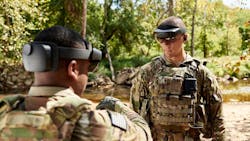Augmented reality could enhance military situational awareness, but what about its electromagnetic signature?
WASHINGTON – There is always something taken away when there are added functionalities. Does the concept of wearing augmented reality that digitally provides situational awareness create an upside that outweighs what it takes away for rifleman skills? C4ISRnet reports. Continue reading original article
The Military & Aerospace Electronics take:
31 July 2020 -- The supercharged hearing, six senses for those equipped, broader view of sight, picking up smells, changes in lights and shadows, slightest change in the near environment: with all these close-action skills, will augmented reality create more distraction than enhancement? Is it too early to push digital situational awareness all the way down to the soldier in maneuver units? Is the upside present?
How reliable are the sensors? Can the sensors be easily spoofed? Is it too early to push it all the way down to the individual soldier? A technologically advanced adversary likely will devote research already in peacetime to develop one-time use, tossable, simple, low-cost devices that can — in close combat — create spurious sensor data and derail augmented reality.
If the integrity of the sensor data is in question, it likely will force commanders to refrain from using augmented reality. A similar, relevant issue is the extent of the augmented reality technology’s electromagnetic signature. Will the interconnectivity of the squad’s augmented reality compromise the unit and deliver information to the enemy?
Related: Army reaches out to industry for ideas on augmented-reality training for NIE 15.1
John Keller, chief editor
Military & Aerospace Electronics
